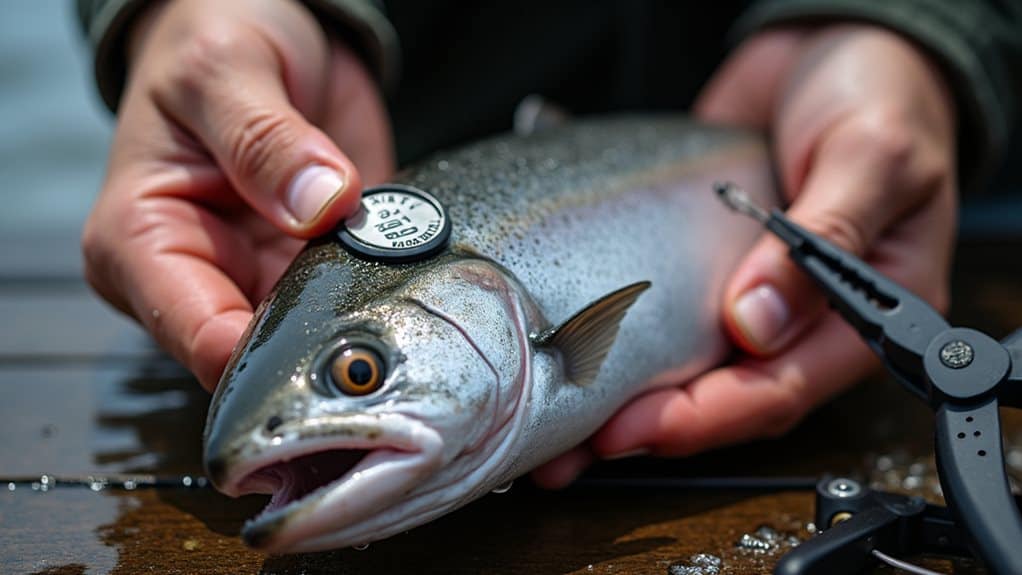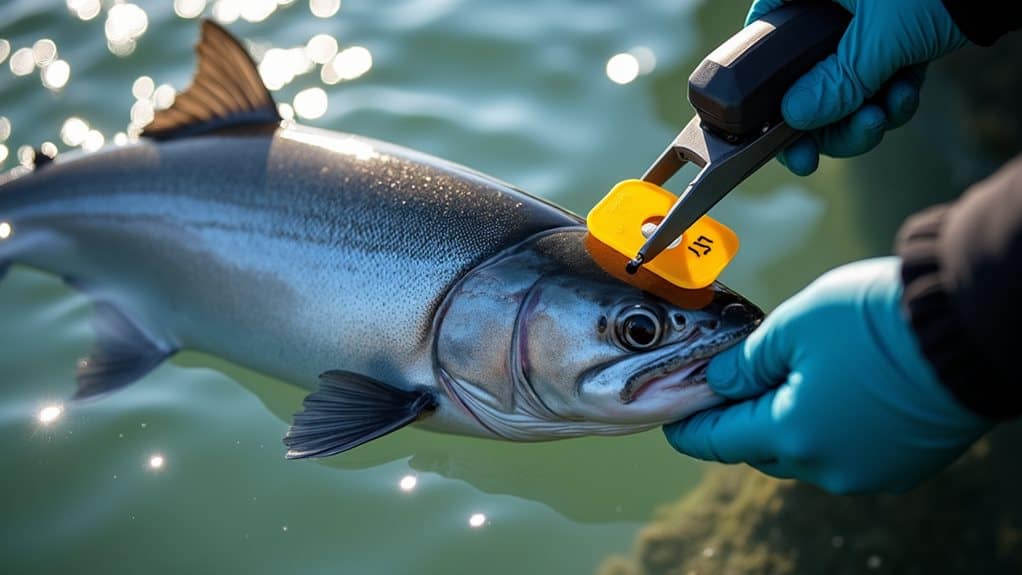You can tag fish using several methods including acoustic tags that transmit sound pulses, satellite tags for tracking migratory species, PIT tags with radio transponders, or simple Carlin tags with stainless steel wires for visual identification. Fish tagging is vital because it provides essential data on migration patterns, population sizes, and survival rates that scientists need for sustainable fisheries management and marine conservation. This research helps protect breeding grounds, reduce bycatch, and establish accurate fishing quotas. Continue exploring to uncover advanced telemetry systems and real-world applications.
TLDR
- Fish tagging uses acoustic, satellite, archival, chemical, and natural methods to track individual fish movements and behavior.
- Physical tags like Carlin tags and PIT tags provide cost-effective identification through visual markers and electromagnetic signals.
- Advanced telemetry systems enable real-time monitoring of fish across river systems and global ocean migrations.
- Tagging research supports sustainable fishing quotas, protects breeding grounds, and reduces harmful bycatch in commercial fisheries.
- Scientists face challenges including inconsistent protocols, funding limitations, and potential impacts on tagged fish survival rates.
Understanding Fish Tagging Methods and Techniques

Fish tagging represents a cornerstone of modern fisheries research, providing scientists with essential tools to understand fish behavior, migration patterns, and population fluctuations. Mastering fishing fundamentals allows researchers to better interpret the data collected from tags.
You’ll encounter five primary tagging methods:
- acoustic tags that transmit unique sound pulses to underwater receivers,
- satellite tags for tracking wide-ranging pelagic species,
- archival tags storing detailed environmental data,
- chemical tagging using temporary dyes,
- and natural tagging utilizing biological markers.
This scientific practice has deep historical roots, with the first successful tagging in the United States occurring in 1873 with Atlantic salmon.
Physical and Mechanical Tagging Approaches
Beyond electronic and chemical methods, physical and mechanical tagging systems offer researchers reliable, cost-effective alternatives that don’t depend on batteries or specialized detection equipment. You’ll find Carlin tags particularly effective for larger fish, using stainless steel wires through the dorsal fin area to secure coded metal plates that provide visual identification throughout the fish’s lifetime. Additionally, these tagging systems can be utilized in various aquatic environments, making them versatile tools for researchers studying fish behavior and habitat in different settings. PIT tags function as glass cylinders containing radio transponders that respond to electromagnetic signals from scanners without requiring any internal power source.
Advanced Telemetry and Remote Tracking Systems
When you’re ready to monitor fish movements across vast distances and extended time periods, advanced telemetry systems offer sophisticated solutions that go far beyond basic tagging methods.
You’ll find that acoustic array networks can track tagged fish across entire river systems or coastal regions, while satellite technology enables global monitoring of highly migratory species like tuna and sharks. These systems rely on various data transmission methods, from underwater acoustic signals to satellite uplinks, allowing you to collect detailed behavioral and movement data remotely without ever needing to recapture the fish. Additionally, locations like Cairns, Australia provide opportunities to study the movement patterns of species such as black marlin.
Acoustic Array Networks
Advanced telemetry systems have revolutionized how researchers track aquatic species across vast ocean territories, with acoustic array networks standing as one of the most sophisticated approaches available today.
You’ll find these networks use coordinated listening stations to detect signals from tagged fish, enabling triangulation of precise locations across habitats and providing essential movement data for conservation efforts.
Satellite Tag Technology
Among the most sophisticated tracking methods available to marine researchers, satellite tag technology represents a quantum leap in our ability to monitor large ocean species across entire ocean basins.
You’ll find these externally attached tags collect GPS positions, depth data, and water temperature as they follow tuna, sharks, and billfish across thousands of nautical miles.
Data Transmission Methods
While satellite technology excels at tracking fish across vast ocean distances, acoustic telemetry systems offer researchers unmatched precision for monitoring fish behavior in more localized environments.
You’ll find high-frequency tags operating at 307-417 kHz provide exceptional accuracy, while injectable transmitters minimize stress by eliminating surgical procedures.
Advanced underwater modems enable real-time data relay for extensive monitoring.
Tag Types and Their Specific Functions

Fish tagging involves several distinct tag types, each designed to serve specific research purposes and address unique challenges in aquatic environments.
You’ll find conventional tags like T-bar tags work well for group identification, while PIT tags provide individual tracking capabilities.
Coded wire tags suit large-scale hatchery studies, and telemetry tags offer real-time monitoring for detailed behavioral research. Additionally, tags can be used to monitor seasonal bass fishing strategies and their movements throughout different times of the year.
Data Collection and Monitoring Capabilities
Once you’ve selected the appropriate tag type for your research objectives, the real value emerges through the sophisticated data collection and monitoring systems these tags enable.
You’ll gather continuous movement data when tagged fish pass acoustic receivers, while satellite tags provide extensive spatial tracking.
This creates detailed behavioral patterns, environmental correlations, and long-term population observations.
Benefits for Fisheries Management and Conservation

Three fundamental pillars support modern fisheries management and conservation efforts, and fish tagging serves as the cornerstone that strengthens each one.
You’ll find that tagging enables accurate population assessments, helping set sustainable quotas while identifying overfished species.
It protects critical breeding grounds, reduces bycatch, and enforces catch limits effectively, ensuring long-term marine ecosystem health.
Challenges and Limitations in Tagging Research
Despite tagging’s significant contributions to fisheries science, researchers face substantial methodological, technical, and logistical obstacles that can compromise study quality and limit conservation applications.
You’ll encounter challenges like inconsistent protocols across research groups, funding constraints that restrict project scope, and physiological impacts on tagged fish that can alter their natural behavior and survival rates.
Real-World Applications and Research Outcomes

While researchers grapple with these methodological obstacles, fish tagging has already produced extraordinary scientific breakthroughs that directly benefit fisheries management, conservation efforts, and our understanding of aquatic ecosystems.
You’ll find that acoustic and satellite tags reveal critical spawning grounds, while PIT tags enable multi-year tracking of individual fish growth and survival patterns, informing adaptive management decisions worldwide.
Final Note
You’ll find that fish tagging represents a cornerstone of modern aquatic research, providing crucial data that drives conservation efforts and sustainable fisheries management. Whether you’re a researcher, angler, or conservation enthusiast, understanding these techniques helps you appreciate the complex science behind protecting fish populations. By supporting tagging programs and reporting tagged fish encounters, you’re contributing to essential research that guarantees healthy aquatic ecosystems for future generations.




